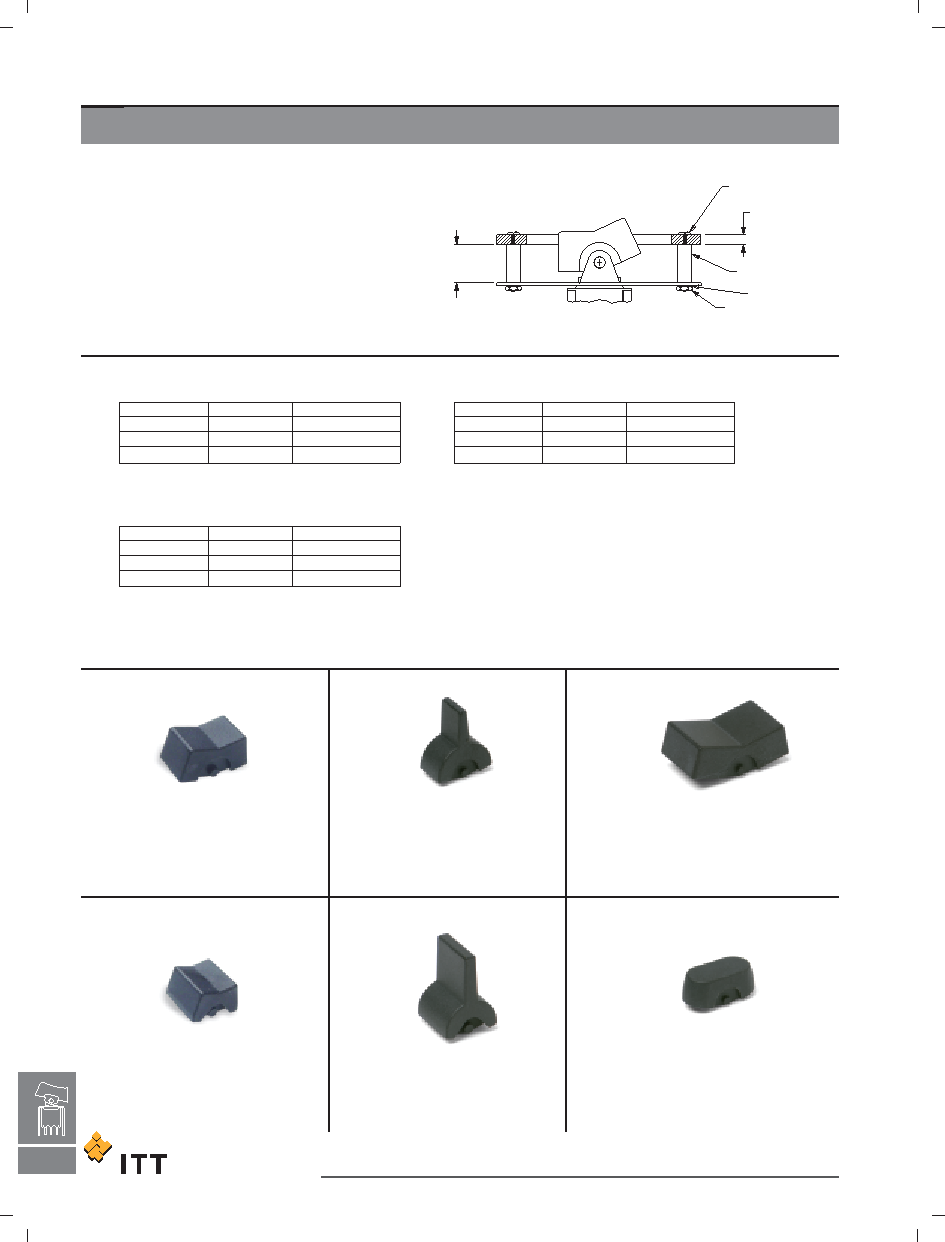- 您現(xiàn)在的位置:買賣IC網(wǎng) > PDF目錄35218 > 7207J2W5SE3 (C K COMPONENTS INC) TOGGLE SWITCH, DPDT, LATCHED AND MOMENTARY, 5A, 28VDC, PANEL MOUNT PDF資料下載
參數(shù)資料
| 型號: | 7207J2W5SE3 |
| 廠商: | C K COMPONENTS INC |
| 元件分類: | 開關(guān) |
| 英文描述: | TOGGLE SWITCH, DPDT, LATCHED AND MOMENTARY, 5A, 28VDC, PANEL MOUNT |
| 封裝: | ROHS COMPLIANT |
| 文件頁數(shù): | 11/22頁 |
| 文件大小: | 2753K |
| 代理商: | 7207J2W5SE3 |

C&K 7000 Series
Miniature Rocker & Lever Handle Switches
AVAILABLE HARDWARE
TYPICAL ASSEMBLY
SCREW
PANEL THICKNESS
STAND-OFF
LOCKWASHER
NUT
STAND-OFF
LENGTH
Panel mounting hardware for rocker and lever handle switches is
available separately. Mounting hardware consists of two screws,
two nuts, two standoffs and two lockwashers per switch, and is
available for panel thicknesses of 1/16, 3/32 and 1/8 inch.
See part numbers below.
J1 & J2 actuators
J10 actuators
J3 actuators
PART NO.
PANEL THK.
STANDOFF LENGTH
761101000
1/16 IN. (1,59)
.295 (7,49)
761102000
3/32 IN. (2,38)
.264 (6,71)
761103000
1/8 IN. (3,18)
.233 (5,92)
PART NO.
PANEL THK.
STANDOFF LENGTH
770701000
1/16 IN. (1,59)
.295 (7,49)
770702000
3/32 IN. (2,38)
.264 (6,71)
770703000
1/8 IN. (3,18)
.233 (5,92)
PART NO.
PANEL THK.
STANDOFF LENGTH
770601000
1/16 IN. (1,59)
.295 (7,49)
770602000
3/32 IN. (2,38)
.264 (6,71)
770603000
1/8 IN. (3,18)
.233 (5,92)
MATERIAL
Screws, nuts, lockwashers: Stainless steel. Standoffs: Nylon, standard.
J1, J11, J15 & J16 Actuators
PART NO.
776A01000 WHITE
776A02263 BLACK
776A03000 RED
Material: Nylon
Finish: Matte
J50, J51 & J52 Actuators
PART NO.
775A01000 WHITE
775A02263 BLACK
775A03000 RED
Material: Nylon
Finish: Matte
J60, J61 & J62 Actuators
PART NO.
598101000
WHITE
613802263
BLACK
598103000
RED
Material: Nylon
Finish: Matte
J8 Actuator
PART NO.
488701000
WHITE
488702263
BLACK
488703000
RED
Material: Nylon
Finish: Matte
J2, J21, J25 & J26 Actuators
PART NO.
760501000
WHITE
760502263
BLACK
760503000
RED
Material: Nylon
Finish: Matte
J3 & J37 Actuators
PART NO.
766601000
WHITE
766602263
BLACK
766603000
RED
Material: Nylon
Finish: Matte
H–22
H
Rocker
Dimensions are shown: Inch (mm)
Specifications and dimensions subject to change
www.ittcannon.com
相關(guān)PDF資料 |
PDF描述 |
|---|---|
| 7207J2Z3QI3 | TOGGLE SWITCH, DPDT, LATCHED AND MOMENTARY, 5A, 28VDC, PANEL MOUNT |
| 7208J2WRE1 | TOGGLE SWITCH, DPDT, LATCHED AND MOMENTARY, 5A, 28VDC, PANEL MOUNT |
| 7208J60V31KE2 | TOGGLE SWITCH, DPDT, LATCHED AND MOMENTARY, 0.02A, 20VDC, THROUGH HOLE-STRAIGHT |
| 7207J90V61KE2 | TOGGLE SWITCH, DPDT, LATCHED AND MOMENTARY, 0.02A, 20VDC, THROUGH HOLE-STRAIGHT |
| 7207J90W3BI2 | TOGGLE SWITCH, DPDT, LATCHED AND MOMENTARY, 0.02A, 20VDC, PANEL MOUNT |
相關(guān)代理商/技術(shù)參數(shù) |
參數(shù)描述 |
|---|---|
| 7207J2ZBE2 | 功能描述:搖臂開關(guān)與扳鈕開關(guān) ON OFF Mom DPDT 20VAC 20VDC 0.4W RoHS:否 制造商:C&K Components 觸點(diǎn)形式: 開關(guān)功能: 電流額定值:50 mA 電壓額定值 AC: 電壓額定值 DC:30 V 功率額定值: 端接類型: 執(zhí)行器:Paddle 顏色: 安裝風(fēng)格:Panel 端子密封: 觸點(diǎn)電鍍: 照明:Not Illuminated 照明顏色: |
| 7207J2ZQE1 | 功能描述:搖臂開關(guān)與扳鈕開關(guān) RoHS:否 制造商:C&K Components 觸點(diǎn)形式: 開關(guān)功能: 電流額定值:50 mA 電壓額定值 AC: 電壓額定值 DC:30 V 功率額定值: 端接類型: 執(zhí)行器:Paddle 顏色: 安裝風(fēng)格:Panel 端子密封: 觸點(diǎn)電鍍: 照明:Not Illuminated 照明顏色: |
| 7207J2ZQE2 | 功能描述:搖臂開關(guān)與扳鈕開關(guān) RoHS:否 制造商:C&K Components 觸點(diǎn)形式: 開關(guān)功能: 電流額定值:50 mA 電壓額定值 AC: 電壓額定值 DC:30 V 功率額定值: 端接類型: 執(zhí)行器:Paddle 顏色: 安裝風(fēng)格:Panel 端子密封: 觸點(diǎn)電鍍: 照明:Not Illuminated 照明顏色: |
| 7207J2ZQE3 | 功能描述:搖臂開關(guān)與扳鈕開關(guān) RoHS:否 制造商:C&K Components 觸點(diǎn)形式: 開關(guān)功能: 電流額定值:50 mA 電壓額定值 AC: 電壓額定值 DC:30 V 功率額定值: 端接類型: 執(zhí)行器:Paddle 顏色: 安裝風(fēng)格:Panel 端子密封: 觸點(diǎn)電鍍: 照明:Not Illuminated 照明顏色: |
| 7207J2ZQI2 | 功能描述:搖臂開關(guān)與扳鈕開關(guān) Rocker RoHS:否 制造商:C&K Components 觸點(diǎn)形式: 開關(guān)功能: 電流額定值:50 mA 電壓額定值 AC: 電壓額定值 DC:30 V 功率額定值: 端接類型: 執(zhí)行器:Paddle 顏色: 安裝風(fēng)格:Panel 端子密封: 觸點(diǎn)電鍍: 照明:Not Illuminated 照明顏色: |
發(fā)布緊急采購,3分鐘左右您將得到回復(fù)。